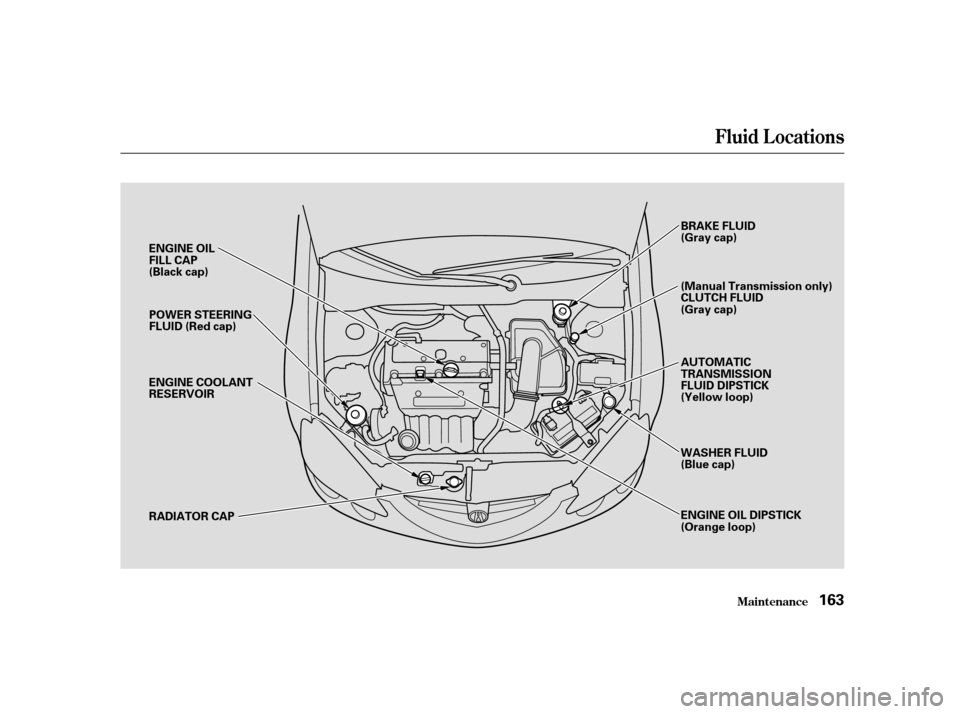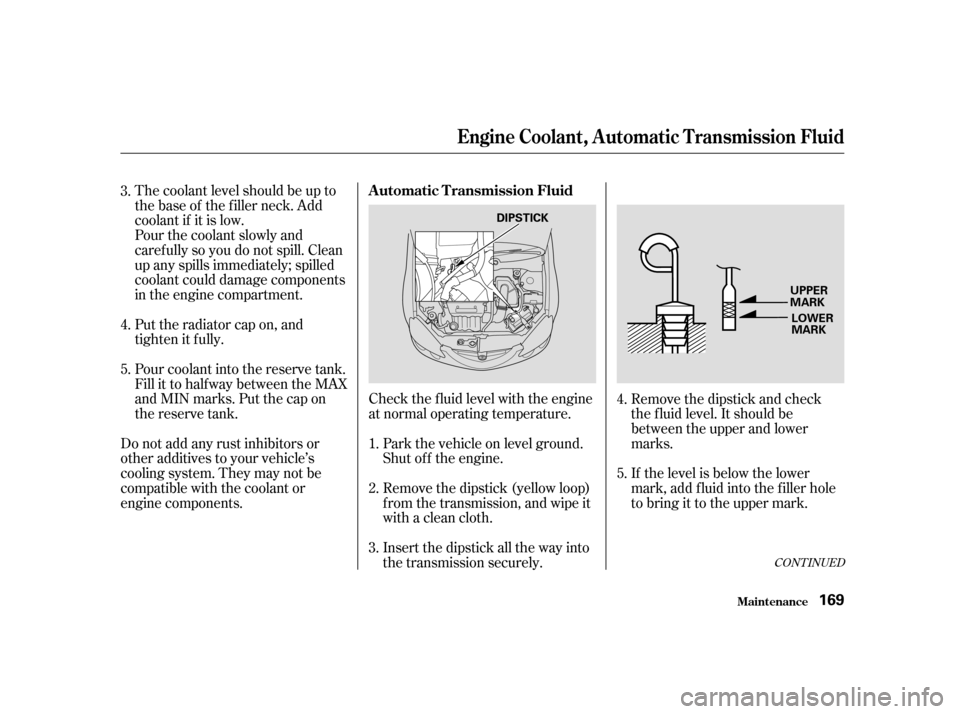radiator cap Acura RSX 2004 Owner's Manual
[x] Cancel search | Manufacturer: ACURA, Model Year: 2004, Model line: RSX, Model: Acura RSX 2004Pages: 250, PDF Size: 3.3 MB
Page 49 of 250

These labels are in the locations
shown. They warn you of potential
hazards that could cause serious
injury. Read these labels caref ully.
If a label comes of f or becomes hard
to read, contact your Acura dealer
f or a replacement.U.S. modelsCanadian models
U.S. models only
Saf ety L abels
Driver and Passenger Saf ety46
RADIATOR CAP SUN VISOR
DASHBOARD
HOOD
Page 166 of 250

Fluid Locations
Maint enance163
ENGINE OIL
FILL CAP
(Black cap)POWER STEERING
FLUID (Red cap)
ENGINE COOLANT
RESERVOIR
RADIATOR CAP BRAKE FLUID
(Gray cap)
(Manual Transmission only)
CLUTCH FLUID
(Gray cap)
AUTOMATIC
TRANSMISSION
FLUID DIPSTICK
(Yellow loop)
WASHER FLUID
(Blue cap)
ENGINE OIL DIPSTICK
(Orange loop)
Page 171 of 250

If Honda antif reeze/coolant is not
available, you may use another
major-brand non-silicate coolant as a
temporaryreplacement.Makesureit
is a high-quality coolant
recommended f or aluminum engines.
Continued use of any non-Honda
coolant can result in corrosion,
causing the cooling system to
malf unction or f ail. Have the cooling
system f lushed and ref illed with
Honda antif reeze/coolant as soon as
possible.When the radiator and engine are
cool, relieve any pressure in the
cooling system by turning the
radiator cap counterclockwise,
without pressing down.
Remove the radiator cap by
pushing down and turning
counterclockwise.
If the reserve tank is completely
empty, you should also check the
coolant level in the radiator.
2. 1.
Engine Coolant
Maint enance168
RADIATOR CAP
Removing the radiator cap
while the engine is hot can
cause the coolant to spray out,
seriously scalding you.
Always let the engine and
radiator cool down before
removing the radiator cap.
Page 172 of 250

CONT INUED
The coolant level should be up to
the base of the f iller neck. Add
coolant if it is low.
Pourthecoolantslowlyand
caref ully so you do not spill. Clean
up any spills immediately; spilled
coolant could damage components
in the engine compartment.
Put the radiator cap on, and
tighten it fully.
Pour coolant into the reserve tank.
Fill it to half way between the MAX
and MIN marks. Put the cap on
the reserve tank.
Do not add any rust inhibitors or
other additives to your vehicle’s
cooling system. They may not be
compatible with the coolant or
engine components. Check the f luid level with the engine
at normal operating temperature.
Park the vehicle on level ground.
Shut of f the engine.
Remove the dipstick (yellow loop)
f rom the transmission, and wipe it
with a clean cloth.
Insert the dipstick all the way into
the transmission securely. Remove the dipstick and check
the f luid level. It should be
between the upper and lower
marks.
If the level is below the lower
mark, add f luid into the f iller hole
to bring it to the upper mark.
1.
2.
3.
4.
5.
3.4.
5.
Engine Coolant, Automatic Transmission Fluid
Maint enance
Automatic Transmission Fluid
169
DIPSTICK
UPPER
MARKLOWER
MARK
Page 206 of 250

Look f or any obvious coolant leaks,
such as a split radiator hose.
Everything is still extremely hot,
so use caution. If you f ind a leak, it
must be repaired bef ore you
continue driving (seeon page ).
If you don’t f ind an obvious leak,
check the coolant level in the
radiator reserve tank. Add coolant
if the level is below the MIN mark.
If there was no coolant in the
reserve tank, you may need to add
coolant to the radiator. Let the
engine cool down until the pointer
reaches the middle of the tempera-
ture gauge, or lower, bef ore check-
ing the radiator. Using gloves or large heavy cloth,
turn the radiator cap
counterclockwise without pushing
down to the first stop. After the
pressure releases, push down on
the cap, and turn it until it comes
off.Start the engine, and set the
temperature control lever to
maximum. Add coolant to the
radiator up to the base of the f iller
neck. If you do not have the
proper coolant mixture available,
you can add plain water.
Remember to have the cooling
system drained and ref illed with
the proper mixture as soon as you
can.
Put the radiator cap back on
tightly. Run the engine and watch
the temperature gauge. If it goes
back to the red mark, the engine
needs repair (see
on page ).
If the temperature stays normal,
check the coolant level in the
radiator reserve tank. If it has
gone down, add coolant to the
MAX mark. Put the cap back on
tightly.
7.
8.9.
6. 5.
10.
11.
215
215
If theEngineOverheats
T aking Care of t he Unexpect ed
Emergency
Towing
Emergency
Towing
203
Removing the radiator cap
while the engine is hot can
cause the coolant to spray out,
seriously scalding you.
Always let the engine and
radiator cool down before
removing the radiator cap.